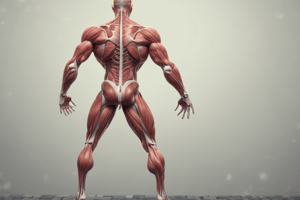Podcast
Questions and Answers
The Soleus tetanus peaks are fused, which means that they do not completely relax before peaking again. Why might the soleus show fused tetanus peaks and higher forces at a lower stimulation frequency than the EDL?
The Soleus tetanus peaks are fused, which means that they do not completely relax before peaking again. Why might the soleus show fused tetanus peaks and higher forces at a lower stimulation frequency than the EDL?
- The EDL is faster at pumping calcium out of the cytoplasm (correct)
- The soleus can generate ATP faster
- The EDL can generate ATP faster
- The soleus absorbs calcium more slowly than the EDL
Why might the EDL fatigue more quickly than the soleus?
Why might the EDL fatigue more quickly than the soleus?
- The EDL uses mostly anaerobic metabolism but the soleus uses mostly aerobic metabolism (correct)
- The EDL uses aerobic metabolism but the soleus uses mostly anaerobic metabolism
- Higher stimulation frequencies used for the EDL cause the membrane to depolarize more
- The EDL is a lazy muscle that just gives up
What are the characteristics of skeletal muscle cells?
What are the characteristics of skeletal muscle cells?
- None of the options are correct
- Walls of the heart, involuntary movement, fast and sustained contractions
- Lining of internal organs, involuntary movement, slow and sustained contractions
- Attached to bones, voluntary movement, rapid and strong contractions (correct)
Where is the origin point of a muscle usually located?
Where is the origin point of a muscle usually located?
Quick question to recap. How do skeletal muscles cause the movement of bones and tissues they are attached to?
Quick question to recap. How do skeletal muscles cause the movement of bones and tissues they are attached to?
How many insertion points can a muscle have?
How many insertion points can a muscle have?
Second one! Which of the following activities involves the use of skeletal muscles?
Second one! Which of the following activities involves the use of skeletal muscles?
What is the function of a synergist muscle?
What is the function of a synergist muscle?
Which muscle involved in the elbow flexion acts as a fixator?
Which muscle involved in the elbow flexion acts as a fixator?
Flashcards
Skeletal Muscle Characteristics
Skeletal Muscle Characteristics
Skeletal muscles attach to bones, allowing voluntary movement through rapid and strong contractions, controlled by the somatic nervous system.
Muscle Origin Point
Muscle Origin Point
The origin is a muscle's anchor point, located on the immovable or less movable bone or tissue, allowing the muscle to pull the insertion point closer.
Muscle Movement
Muscle Movement
Skeletal muscles cause movement through contraction. They pull bones and tissues closer or further away, creating various movements.
Muscle Insertion Points
Muscle Insertion Points
Signup and view all the flashcards
Synergist Function
Synergist Function
Signup and view all the flashcards
Deltoid in Elbow Flexion
Deltoid in Elbow Flexion
Signup and view all the flashcards
EDL Calcium Pumping
EDL Calcium Pumping
Signup and view all the flashcards
EDL Metabolism
EDL Metabolism
Signup and view all the flashcards
Study Notes
- The soleus tetanus peaks are fused because they do not completely relax before peaking again.
- Fused tetanus peaks are caused by calcium ions remaining inside the fibers of the soleus.
- The EDL (Extensor Digitorum Longus) is faster at getting rid of the calcium ions, preventing tetanus at low stimulation frequencies.
Reason for EDL fatigue
- The EDL fatigues more quickly than the soleus.
- Reason: The EDL uses mostly anaerobic metabolism, while the soleus uses mostly aerobic metabolism.
- The EDL uses anaerobic metabolism to achieve faster speeds.
Characteristics of Skeletal Muscle Cells
- Skeletal muscle cells are attached to bones and are responsible for voluntary movement.
- Skeletal muscles facilitate rapid and strong contractions.
- Contractions are controlled by somatic nervous system
Muscle Origin Point
- The origin point of a muscle is usually located at the immovable or less movable bone or tissue.
- Origin is the muscle's anchor.
- When the muscle contracts, it pulls the insertion point on the movable bone closer to the origin point.
Muscle Movement
- Skeletal muscles cause movement through contraction.
- Through contraction, skeletal muscles pull bones and soft tissues closer together or further away.
- Muscles attach to different locations and work together to create complex movements.
Muscle Insertion Points
- Skeletal muscles can have more than one insertion point.
- Additional insertion points enhance the muscle's force or cause movement in multiple bones or tissues.
Activities Using Skeletal Muscles
- Skeletal muscles are used during sports, singing, and even sleeping on surfaces that do not support the spine, like wet sand.
Synergist Muscles
- Synergist muscles stabilize the action of the prime mover by preventing shifts at intermediate joints.
- Specialized synergists that stabilize the origin are called fixators.
Elbow Flexion Fixator
- The deltoid muscle involved in elbow flexion acts as a fixator.
- The deltoid stabilizes the origin of the biceps brachii, allowing for stable flexion movement.
Studying That Suits You
Use AI to generate personalized quizzes and flashcards to suit your learning preferences.




